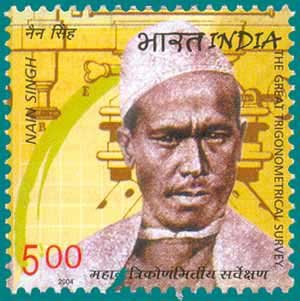Nain Singh (1830-1882)

Technical Data
| Stamp Set | The Great Trigonometrical Survey |
|---|---|
| Date of Issue | June 28, 2004 |
| Denomination | Rs. 5 |
| Quantity | 800,000 |
| Perforation | comb 13 x 13½ |
| Printer | Calcutta Security Printers Ltd |
| Watermark | No Watermark |
| Colors | Multicolor |
| Catalog Codes |
Michel IN 2029 Stamp Number IN 2065 Yvert et Tellier IN 1795 Stanley Gibbons IN 2207 WADP Numbering System - WNS IN016.04 |
| Themes | Famous people | Geodesy and Surveying | Headgear | Measuring Instruments | Men |
Table of Contents
Nain Singh (1830-1882)
Nain Singh was a remarkable figure in the history of surveying and exploration in India, known for his pioneering efforts in mapping Tibet. Here are some key points about his life and contributions:
Birth and Background:
Born in 1830, Nain Singh belonged to a family of surveyors. He was educated in traditional Indian ways but had a keen interest in geography and science.
Exploration of Tibet:
He undertook significant explorations in Tibet, a region that was largely sealed off from outsiders at the time. Disguised as a lama, he managed to enter Tibet and conduct surveys.
Surveying Techniques:
Nain Singh used a variety of instruments hidden within his belongings, including a compass, sextant, and chronometer. His meticulous approach allowed him to gather valuable data.
Mapping Achievements:
Over 21 months, he surveyed a 2000 km trade route and took latitude fixes at 31 locations. He is credited with proving that the Tsangpo River in Tibet and the Brahmaputra River in India are the same river.
Recognition:
His work greatly contributed to the understanding of the geography of the region and was instrumental in mapping Tibet for the British Empire. His explorations laid the groundwork for future studies of the Himalayas and surrounding areas.
Death:
Nain Singh passed away in 1882, leaving behind a legacy of exploration and scientific inquiry that continues to be recognized in the fields of geography and surveying.
His contributions have been celebrated as part of the broader history of the Great Trigonometrical Survey, which significantly advanced geographical knowledge in India.
